
Pannonia was a province of the Roman Empire bounded on the north and east by the Danube, coterminous westward with Noricum and upper Italy, and southward with Dalmatia and upper Moesia. Pannonia was located in the territory that is now western Hungary, western Slovakia, eastern Austria, northern Croatia, north-western Serbia, northern Slovenia, and northern Bosnia and Herzegovina.
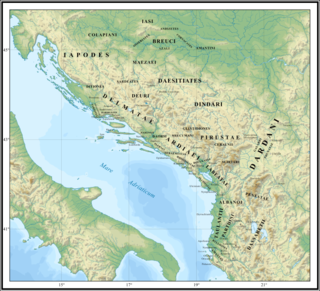
In classical antiquity, Illyria was a region in the western part of the Balkan Peninsula inhabited by numerous tribes of people collectively known as the Illyrians.
The Dardani or Dardanians were a Paleo-Balkan people, who lived in a region that was named Dardania after their settlement there. They were among the oldest Balkan peoples, and their society was very complex. The Dardani were the most stable and conservative ethnic element among the peoples of the central Balkans, retaining for several centuries an enduring presence in the region.

Medun is a settlement located 13 km northeast of the capital Podgorica, Montenegro. The village houses the archaeological site of the ancient fortified city of Medeon. It is situated in the tribal area of Upper Kuči, one of the highland tribes. In the 2003 census, it had 108 inhabitants. In ancient times, Medun was inhabited by the Illyrians between the 4th and 3rd centuries BC.

The Illyriciani or Illyrian emperors were a group of Roman emperors during the Crisis of the Third Century who hailed from the region of Illyricum, and were raised chiefly from the ranks of the Roman army.
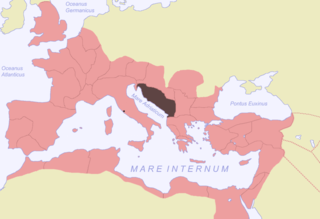
Illyricum was a Roman province that existed from 27 BC to sometime during the reign of Vespasian. The province comprised Illyria/Dalmatia in the south and Pannonia in the north. Illyria included the area along the east coast of the Adriatic Sea and its inland mountains, eventually being named Dalmatia. Pannonia included the northern plains that now are a part of Serbia, Croatia and Hungary. The area roughly corresponded to part or all of the territories of today's Albania, Kosovo, Montenegro, Serbia, Bosnia and Herzegovina, Croatia, and Slovenia.
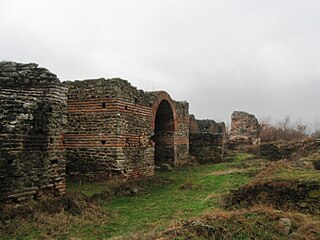
Justiniana Prima was an Eastern Roman city that existed from 535 to 615, and currently an archaeological site, known as or Caričin Grad, near modern Lebane in the Leskovac region, southern Serbia. It was founded by Emperor Justinian I (527-565) and served as the metropolitan seat of the then newly founded Archbishopric of Justiniana Prima, which became the main church administrative body of the central and western Balkans with jurisdiction from Praevalitana to Dacia Ripensis. Justinian Prima was originally designed to become the capital of the prefecture of Illyricum, but for reasons likely related with its status near the Roman frontiers of the 6th century CE, Thessaloniki was preferred. It was abandoned less than 100 years after its foundation.

Pannonia Savia or simply Savia, also known as Pannonia Ripariensis, was a Late Roman province. It was formed in the year 295, during the Tetrarchy reform of Roman emperor Diocletian, and assigned to the civil diocese of Pannonia, which was attached in the fourth century to the Praetorian prefecture of Illyricum, and later to the Praetorian prefecture of Italy.

The Diocese of Pannonia, from 395 known as the Diocese of Illyricum, was a diocese of the Late Roman Empire. The seat of the vicarius was Sirmium.
The term Thraco-Roman describes the Romanized culture of Thracians under the rule of the Roman Empire.
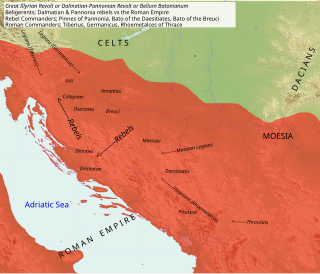
The Bellum Batonianum was a military conflict fought in the Roman province of Illyricum in the 1st century AD, in which an alliance of native peoples of the two regions of Illyricum, Dalmatia and Pannonia, revolted against the Romans. The rebellion began among native peoples who had been recruited as auxiliary troops for the Roman army. They were led by Bato the Daesitiate, a chieftain of the Daesitiatae in the central part of present-day Bosnia and Herzegovina, and were later joined by the Breuci, a tribe in Pannonia led by Bato the Breucian. Many other tribes in Illyria also joined the revolt.

Dacia Aureliana was a province in the eastern half of the Roman Empire established by Roman Emperor Aurelian in the territory of former Moesia Superior after his evacuation of Dacia Traiana beyond the Danube in 271. Between 271/275 and 285, it occupied most of what is today northwestern Bulgaria and eastern Serbia. Its capital was in Serdica.

The Diocese of Dacia was a diocese of the later Roman Empire, in the area of modern western Bulgaria, central Serbia, Montenegro, northern Albania and northern North Macedonia. It was subordinate to the Praetorian prefecture of Illyricum. Its capital was at Serdica.
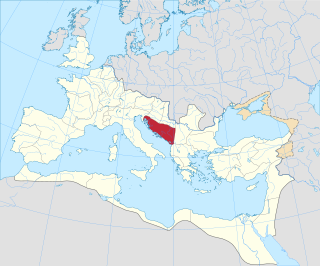
Dalmatia was a Roman province. Its name is derived from the name of an Illyrian tribe called the Dalmatae, which lived in the central area of the eastern coast of the Adriatic Sea. It encompassed the northern part of present-day Albania, much of Croatia, Bosnia and Herzegovina, Montenegro, Kosovo and Serbia, thus covering an area significantly larger than the current Croatian region of Dalmatia. Originally this region was called Illyria or Illyricum.

Praevalitana was a Late Roman province that existed between c. 284 and c. 600. It included parts of present-day Montenegro, northern Albania, and part of present-day Kosovo. Its capital city was Doclea, later Scodra.

Dardania was a Roman province in the Central Balkans, initially an unofficial region in Moesia (87–284), and then a province administratively part of the Diocese of Moesia (293–337). It was named after the tribe of the Dardani who inhabited the region in classical antiquity prior to the Roman conquest.

Much of the territory of the modern state of Serbia was part of the Roman Empire and later the Eastern Roman Empire. In particular, the region of Central Serbia was under Roman rule for about 800 years, starting from the 1st century BC, interrupted by the arrival of the Slavs into the Balkans during the 6th century, but continued after fall of the First Bulgarian Empire in the early 11th century and permanently ended with the rise of the Second Bulgarian Empire in the late 12th century. The territories were administratively divided into the provinces of Moesia, Pannonia and Dardania. Moesia Superior roughly corresponds to modern Serbia proper; Pannonia Inferior included the eastern part of Serbia proper; Dardania included the western part of Serbia proper. After its reconquest from the Bulgarians by Emperor Basil II in 1018, it was reorganized into the Theme of Bulgaria.
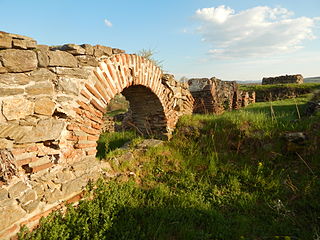
Archbishopric of Justiniana Prima was an Eastern Christian autonomous Archbishopric with see in the city of Justiniana Prima and jurisdiction over the Late Roman Diocese of Dacia in central parts of the Southeastern Europe.

Moesia Prima was a frontier province of the late Roman Empire, situated in the central parts of present-day Serbia, along the south bank of the Danube River. Provincial capital was Viminacium, near modern Kostolac in Serbia).














